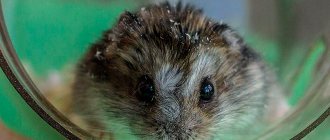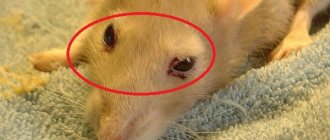Symptoms of the disease
Eye diseases in hamsters can be recognized by the following signs:
- the hamster's eye is very swollen and does not open;
- the eyelid area is always wet and sticks together;
- the hamster's eye waters, a purulent fluid of a grayish or yellowish color is constantly secreted, sometimes with blood;
- a stye or lump may appear;
- inflamed areas become red.
These are clear signs that there is inflammation inside the animal’s small body. This is why a hamster's eyes won't open. A sick pet will behave differently - its activity sharply decreases, it becomes inactive, and sleeps most of the time of the day. During this illness, hamsters may completely refuse to feed and drink.
This may be conjunctivitis, the treatment of which is very complex and lengthy. But often the hamster’s organ of vision turns sour and festers due to other diseases, which are much more difficult to cure. For example, if it’s a cold, the hamster’s eye festers, plus he may sneeze, cough, and wheezing appears in his breathing.
How to deal with this scourge? Our tips and recommendations below will help you with this. But first, we will list the main diseases of the organs of vision in the domestic hamster.
Differences in appearance
The Djungarian hamster and the Campbell's are very similar. They have approximately the same weight and size and can mate with each other, so it is likely that a pet store may sell hybrids that have characteristics of both species. But still, each type has its own differences.
By coat type and color
The greatest differences between these types of hamsters are external.
Distinctive features of dzhungariks:
- White belly and arches on the sides, which are called vaults.
- There is no pattern on the fur other than its natural one.
- Smooth dense fur.
- But on the head there is a darkening of the fur in the form of a diamond. There are also dark spots on the sides.
- The base of the hair on the abdomen is white.
Did you know? Hamsters are one of the few animals that already have teeth at birth. Rodents' teeth grow throughout their lives, so the animal must constantly grind them down. Based on color, Djungarian hamsters are divided into :
- brown-gray with white belly (standard);
- white-gray (pearl);
- gray-blue with a white belly (sapphire);
- red-cream (mandarin).
Two types of hamsters have a dark stripe on their back, but in the Djungarian it is wider. Winter molting is also typical for animals of this species. This process depends on the length of daylight hours. As soon as the days become short, over the course of 6 weeks the dzhungarik changes color to almost white. This is due to the production of the hormone melatonin.
Did you know? Male Campbell's hamsters help females during childbirth: they remove the cubs, clean the newborn's nostrils, and carry them to the nest. If the female leaves the nest, they remain to look after the offspring.
Distinctive features of Campbell's hamsters:
- Some individuals of this species also have arches, but they are not as clearly defined as those of the Dzungarians.
- The fur is more protruding because it grows at a greater angle to the body.
- The color is mainly red, but they can be of various colors: from white to black. In nature, the coat color is dark gray with brown areas.
- On the back the dark stripe is narrower, but more clearly defined. There is no darkened diamond on the sides and head.
- The base of the hair on the abdomen is gray.
- Does not change coat color for the winter.
Dimensions
The size of individuals of the two species is the same - 7–10 cm in length, the weight of an adult rodent is 60–70 g. Since the size of the animal is small, it can live in a small cage or a small aquarium.
Body type
The Djungarian hamster is shaped like an egg. The line of his head flows smoothly into his nose. Campbell's hamster's body is shaped like a figure eight. That is, this species has a pronounced waist. Their nose looks like a small bump. An animal of this species has smaller ears.
Did you know? Campbell's hamsters were named after a member of the British consular service in China, Charles William Campbell.
Eye color
The eye color of hamsters is mostly black. But it is possible to meet healthy animals with red and ruby eyes. These are mainly white and ivory rodents. An animal inherits eye color depending on dominant or recessive alleles. Sometimes an ordinary couple gives birth to a completely white baby with red eyes. This is an albino. For rodent breeders, such a specimen is very valuable, since the absence of the melanin pigment is not transmitted by genes, but is obtained by chance.
If it doesn't open
Only the attending physician - a veterinarian - can help establish the correct diagnosis. Therefore, if the hamster’s eyes do not open, you urgently need to take your pet and take it for examination.
If for some reason you are currently unable to visit a veterinarian, you will need to do the following:
- A hamster whose eyes are sour, inflamed and completely closed should be quarantined, that is, separated from his fellow cagemates.
- The animal’s home, as well as all accessories that are in it, must be disinfected (a solution of potassium permanganate or soda solution can be used as an antiseptic).
- At home, you can drip a rodent's eye with special Albucid drops, which are sold in any pharmacy. You need to drip every day so that your hamster's inflamed and swollen eyelids fully open.
But before instilling this medicine, you need to treat the inflamed area with saline solution. Soak a cotton swab in the warm solution and drop it onto the inflamed area. In the absence of saline solution, you can use ordinary boiled water. Its temperature should not be higher than room temperature. With suppuration, bleeding and protrusion of the organs of vision in hamsters, the drug “Tsiprovet” helps very well.
Tumors and neoplasms
Tumors (malignant, benign), pathological growths on the body, legs. ears is a fairly commonly diagnosed pathology in rodents, which can develop for a variety of reasons. Bumps can appear due to injuries, severe bruises, or falls from a height. To begin treatment, you need to establish a diagnosis, so take your pet to a veterinarian.
For benign and malignant tumors, surgical treatment will be prescribed. If the cancer is localized in a hard-to-reach area (oral cavity), the tumor has metastasized, veterinarians recommend euthanizing the patient.
Redness
You can wash your eyes yourself
If a hamster has one eye closed, but has not festered, but only turned red, at first you can help him on your own. At home, you can make a weak saline solution from boiled water and wash the inflamed organ with it several times a day. Salt as an antiseptic eliminates any pathogenic microflora formed on the mucous membrane. You can also use chamomile infusion or black tea brew as an antiseptic. You need to wash your hamster's inflamed organs of vision at least three times a day.
If such preventive treatment is useless and you have not opened your pet's eyes, you need to take your pet and show it to a veterinarian.
Conjunctivitis
This disease affects not only people, but also animals - the hamster is no exception. Moreover, the treatment of such a disease is quite difficult for domestic hamsters. In some cases, if timely measures are not taken, the animal may simply die.
Conjunctivitis is the initial stage of one of the most serious pathologies in an animal. If a hamster's eye festers and does not open, perhaps some kind of infection or virus has settled inside its body. At an advanced stage, conjunctivitis can cause the development of keratitis, and then it is not far from such a pathology as protrusion of the cornea. What to do in such a situation so as not to trigger the disease?
Therefore, if a hamster’s eye is swollen, very swollen, and its owner does not pay attention to his pet, first the rodent may go blind, then die completely.
The same outcome awaits those pet rodent lovers who do not approach the treatment of their animals competently. Remember that any treatment prescribed independently can result in disastrous consequences for your own household.
With a timely response to an animal's illness, you will never have a question about why the hamster's eye popped out or why it was completely closed and festered.
Rules for caring for albino hamsters
Caring for snow-white hamsters is almost no different from caring for other rodents. But there are several features in their content that should be taken into account so that the pet feels calm and comfortable:
- Animals with white coats do not like to be close to other hamsters, so it is advisable to keep them in a separate cage. This is especially true for miniature albino jungarians, who often show aggression towards other rodents;
- The owner will have to frequently change the bedding in the pet’s home to prevent infection from entering the animal’s sensitive eyes;
- Cage size is also important when keeping these unusual animals. The cage should be spacious and equipped with a running wheel, shelves at different levels and a swing;
- Snow-white rodents love secluded places where they can hide from everyone. For example, the albino Syrian hamster needs a house in which it spends most of the daytime, escaping the light and sun;
- Hamsters with snow-white fur should not be bathed. To make their coat look well-groomed, just put a bath with special sand in the cage;
- These animals are very shy, so it is necessary to protect them from noise and loud sounds. It doesn’t matter what breed your pet is, a miniature Djungarian hamster, or a fluffy snow-white Syrian, the main thing is to devote enough time and attention to your unusual pet, because each of them needs the love and care of the owner.
Blepharitis
This disease may be a consequence of advanced conjunctivitis. In this case, the inflamed eyelid sticks together, and the inflammatory process spreads deeper and deeper inside. At an advanced stage, both organs of vision may be closed. This disease is accompanied by redness and swelling of the eyelids.
What to do in this case? This disease can be treated if you consult a veterinarian in time. Often the treatment regimen is identical to the treatment regimen for conjunctivitis. Often, special eye drops are used in the treatment of this disease, for example Tsiprovet or Floxal, as well as additionally tetracycline ointment.
With this disease, the hamster should be put on a diet and the cage should be disinfected.
What tests need to be taken before lens replacement surgery? Which doctors should I go to?
Before the operation we require without fail:
- Complete blood count + ESR + platelets. Valid for 10 days.
- Blood sugar. Valid for 10 days.
- RW (syphilis). Valid for 1 month.
- Hepatitis B and C. Expiration date: 3 months.
- HIV. Valid for 3 months.
- Fluorography (x-ray of the lungs). Valid for 1 year.
- ECG. Valid for 1 month.
- Dentist consultation. Valid for 1 month.
- ENT consultation. Valid for 1 month.10.
- Consultation with a therapist. Valid for 1 month.
- If you have a history of diabetes mellitus, consult an endocrinologist. Valid for 1 month.
Why so many tests?
Bulging eyes
This is more likely not a disease, but a consequence of injury to the eyeball, which has a bad effect on the general condition of the animal. A hamster can damage its eyes both in the fight against other rodents for survival and from dangerous objects contained in the cage - wood chips, sawdust, wire, etc.
As a result of injury, the invading pathogenic bacteria begins to rapidly multiply, penetrating even under the eyeball itself. Such a pet will most likely face surgery to remove the damaged organ. Otherwise, the bacterial infection can develop further, affecting the entire body. Then the rodent can no longer be saved.
Belmo
A separate case, although not uncommon, is when a hamster has a white spot on its eye. Veterinarians call this pathology a thorn. The main reason that a hamster's eye turns white is trauma, in some cases cataracts.
It also happens that a hamster has a white spot on his eye that completely covers the entire eye. Homkin's white eyes need to be examined by a veterinarian to determine whether it is an injury or indeed a cataract. But neither one nor the other is an infectious disease, so it cannot be treated with any drops or ointments. Your pet will continue to live, but with the resulting defect.
What complications can occur after cataract surgery?
Complications after surgery can vary and depend on how thoroughly the patient prepared for cataract removal. That is why we ask for a wide range of tests and expert opinions so as not to miss an alarm signal and minimize complications. It also directly depends on the preparation for the operation - whether the patient has followed all the recommendations. And from maintaining hygiene after replacing the lens. If the patient has completed all the preparatory steps and doctor’s prescriptions, there are usually no complications and the results of the operation are pleasing to the patient, his family and us.
Takhchidi H.P. et al. Intraocular correction in surgery of complicated cataracts. – M.: Publishing house “New in Medicine”, 2004.
Khodzhaev N.S. Cataract surgery using small incisions: clinical and theoretical justification: Dis. ...Dr. med. nauk.- M., 2000.
Eye pseudo-diseases
Monitor your hamster's immunity
Often the cause of eye inflammation in a domestic hamster can be another disease. This phenomenon is possible if the rodent’s cheek pouches become inflamed. As a result, the animal's eye hurts, waters, and the lower eyelid swells. After some time, the eye can be observed to stick together and increase in size.
In such a situation, you need to do the following - seek help from a veterinarian. There is such a procedure as cleaning the cheeks. It will not only ease your pet’s suffering, but also relieve such consequences as redness, swelling, inflammation and suppuration of the eyes.
When to sound the alarm
How to understand that a hamster is sick. If the animal is healthy, it is active, it has smooth shiny fur, clear, clean eyes and a good appetite. But if you notice that your pet is behaving unusually, take immediate action. Your hamster is sick if some of the following symptoms are noticeable:
- eats poorly or refuses food altogether;
- eyes become watery or festering;
- frequent loose stools;
- constipation, dry stool or no stool at all;
- blood dripping from the anus;
- difficulty or hoarse breathing, cough;
- nasal discharge or excessive drooling;
- wet or dull, matted fur;
- ulcers, wounds, peeling skin, bald spots on the skin;
- tumors, bloating;
- lethargy, low mobility;
- the hamster is trembling, although the room is warm.
An animal's underweight may also be a sign of illness. To find out if your pet is sick, weigh your pet periodically. The weight of an adult Syrian is about 90 g, the weight of a Djungarian is at least 30 g.
Treatment of diseases
After the examination and identification of the disease, the veterinarian prescribes treatment for his “little patient,” which consists of several stages:
- if a hamster’s eye festers, this is a sign of a bacterial infection that needs to be destroyed;
- saving the eyeball, if possible;
- reduce the risk of further damage to the organ of vision;
- numb the painful area;
- and only at the very end the specialist begins to treat the underlying disease that caused inflammation of the visual organs (glaucoma, dental disease, injury, etc.).
Diet restrictions
Consider one more point: the immunity of a sick rodent, like that of any pet, weakens during illness. Therefore, special attention should be paid to nutrition here. You can feed the animal only approved products. You should also exclude some permitted treats from your diet so as not to aggravate the course of the disease.
Dietary treatment consists of cereals, a small portion of animal protein. The animal's water needs to be changed several times a day.
If within a few days you have not noticed an improvement in the condition of your sick pet, you have no other choice but to take him to the veterinarian.
Metabolic disorders
Metabolism is the proper functioning of all body systems. Food processing, energy production, removal of unnecessary and harmful products. The central nervous system is responsible for all this, but the glands that secrete hormones have a huge influence on metabolic processes. These include the thyroid and pancreas, adrenal glands, pituitary gland, and gonads. Poor nutrition, poor environment, and hereditary factors affect the functioning of these organs. Violation of their normal functioning leads to a malfunction of the body as a whole. Diseases of Djungarian hamsters are often associated with metabolic disorders.
Diabetes mellitus can develop due to excessive consumption of carbohydrates. Hereditary predisposition to the disease also plays a role. You can find out that a hamster has contracted this disease by the characteristic smell of acetone, which comes from the rodent's saliva and urine. But only a doctor can make a final diagnosis by doing a blood test. Prevention of disease in Djungarian hamsters is a balanced diet, eliminating sugar from the diet, good care and an active lifestyle.
Stroke can also be classified as a disease that occurs due to metabolic disorders. With age and as a result of poor nutrition, cholesterol plaques are deposited on the walls of blood vessels, which prevent the normal passage of blood. At some point, the plaques completely block the vessel, it bursts, and hemorrhage occurs.
If your hamster is shaking or having convulsions, the end is probably near.
Sometimes attentive owners are concerned that the rodent has a yellow sore on its stomach. In fact, this is a scent gland, with the help of which the male marks his territory.
Preventive measures
Agree, it is better to prevent any disease in domestic hamsters than to treat it later. And for this you need to create the necessary conditions for your pet. Considering the causes of such diseases, caring owners should:
- Use cage mats specifically designed for hamsters. Such material should not contain piercing or cutting objects, as well as a lot of dust.
- You should not keep a large number of rodents in one cage. They can injure each other, which will result in various diseases, including eye diseases.
- Genetically predisposed individuals must be immediately excluded from the general “herd.” Such hamsters can be a carrier of an infection from birth, transmitted to them from their mother or father.
- During the keeping process, the cage with rodents must be placed in a bright place, but protected from the sun. Direct exposure to sunlight and ultraviolet radiation negatively affects the health of pets.
- Regular examination of animals will help you at an early stage to identify not only carriers of diseases, but also to prevent the development of an already established disease in hamsters.
Life expectancy of albinos
The white hamster with red eyes is found in every breed of rodent. Hence the different life expectancies of albinos.
- Djungarian hamsters live for about two to three years. Some individuals live for four years.
- The lifespan of a Syrian is three years. There are rodents that live up to six years.
- Campbell's species rarely lives for more than two years.
- The lifespan of a Roborovsky hamster is two and a half years.
- The shaggy dwarf rodent rarely lives more than two years.
The lifespan of a snow-white animal depends not only on the breed, but also on the conditions of detention, nutrition and care. If you feed your pet high-quality food, show it to the veterinarian on time, and keep the cage clean, then its life expectancy increases.










